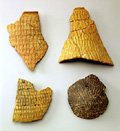Early Jomon(Approx. 10,000 - 8,000 years ago)
Remains from this period consist of the Toguchi Agaribaru ruins of Yomitan-son, the Point B Noguni Shell Mound of Kadena-cho, and the Yabuchi Cave Ruins of Yonashiro-cho. Most of the ruins are situated by the seashore, which indicates a fishing lifestyle for those that lived there. The oldest earthenware pottery in Okinawa is the Tsumegatamon-doki, which have impressions of the makers' fingertips and fingernails on them. This type of pottery is estimated to be around 6,700 years old and is also known as Yabuchi type and Agaribaru type earthenware.
The First-half of the Jomon Period(Approx. 8,000 - 5,000 years ago)
The sites from this period have yielded earthenware produced by Kyushu Jomon peoples and it is thought that boats crossed over from Kyushu bringing these items.
Middle Jomon Period(Approx. 5,000 - 4,000 years ago)
During this period the peoples of the mountainous regions held power in Kyushu and due to this and the enormous amount of volcanic activity, no Kyushu Jomon culture passed to Okinawa in this period. As a result the prehistoric Nanto central cultural sphere developed its own original culture during this period. Shell mounds have been discovered from this period so it is thought that these people lived in settlements.
